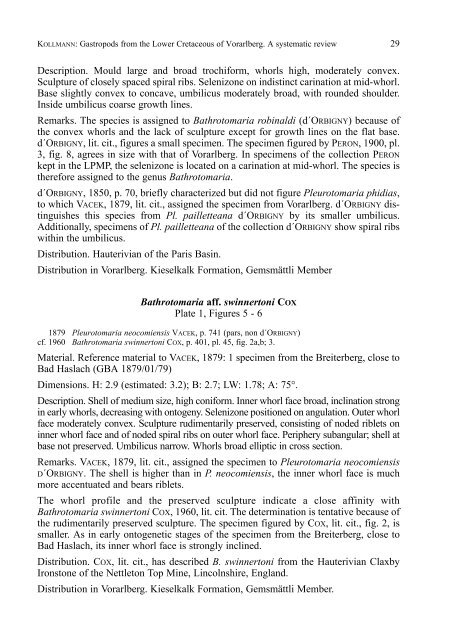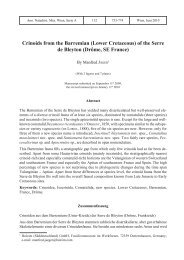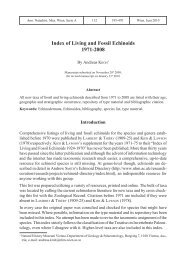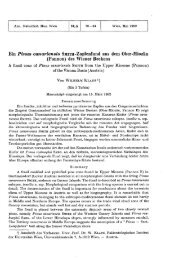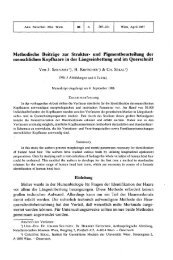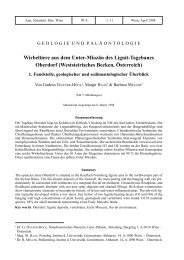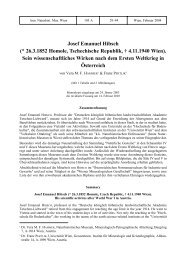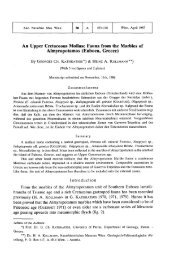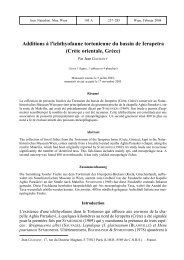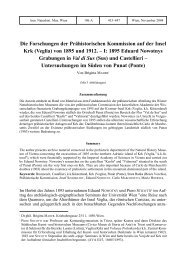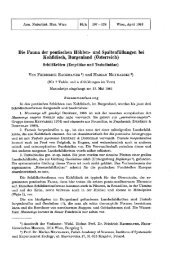Gastropods from the Lower Cretaceous of Vorarlberg, Austria. A ...
Gastropods from the Lower Cretaceous of Vorarlberg, Austria. A ...
Gastropods from the Lower Cretaceous of Vorarlberg, Austria. A ...
Create successful ePaper yourself
Turn your PDF publications into a flip-book with our unique Google optimized e-Paper software.
KOLLMANN: <strong>Gastropods</strong> <strong>from</strong> <strong>the</strong> <strong>Lower</strong> <strong>Cretaceous</strong> <strong>of</strong> <strong>Vorarlberg</strong>. A systematic review 29<br />
Description. Mould large and broad trochiform, whorls high, moderately convex.<br />
Sculpture <strong>of</strong> closely spaced spiral ribs. Selenizone on indistinct carination at mid-whorl.<br />
Base slightly convex to concave, umbilicus moderately broad, with rounded shoulder.<br />
Inside umbilicus coarse growth lines.<br />
Remarks. The species is assigned to Bathrotomaria robinaldi (d´ORBIGNY) because <strong>of</strong><br />
<strong>the</strong> convex whorls and <strong>the</strong> lack <strong>of</strong> sculpture except for growth lines on <strong>the</strong> flat base.<br />
d´ORBIGNY, lit. cit., figures a small specimen. The specimen figured by PERON, 1900, pl.<br />
3, fig. 8, agrees in size with that <strong>of</strong> <strong>Vorarlberg</strong>. In specimens <strong>of</strong> <strong>the</strong> collection PERON<br />
kept in <strong>the</strong> LPMP, <strong>the</strong> selenizone is located on a carination at mid-whorl. The species is<br />
<strong>the</strong>refore assigned to <strong>the</strong> genus Bathrotomaria.<br />
d´ORBIGNY, 1850, p. 70, briefly characterized but did not figure Pleurotomaria phidias,<br />
to which VACEK, 1879, lit. cit., assigned <strong>the</strong> specimen <strong>from</strong> <strong>Vorarlberg</strong>. d´ORBIGNY distinguishes<br />
this species <strong>from</strong> Pl. pailletteana d´ORBIGNY by its smaller umbilicus.<br />
Additionally, specimens <strong>of</strong> Pl. pailletteana <strong>of</strong> <strong>the</strong> collection d´ORBIGNY show spiral ribs<br />
within <strong>the</strong> umbilicus.<br />
Distribution. Hauterivian <strong>of</strong> <strong>the</strong> Paris Basin.<br />
Distribution in <strong>Vorarlberg</strong>. Kieselkalk Formation, Gemsmättli Member<br />
Bathrotomaria aff. swinnertoni COX<br />
Plate 1, Figures 5 - 6<br />
1879 Pleurotomaria neocomiensis VACEK, p. 741 (pars, non d´ORBIGNY)<br />
cf. 1960 Bathrotomaria swinnertoni COX, p. 401, pl. 45, fig. 2a,b; 3.<br />
Material. Reference material to VACEK, 1879: 1 specimen <strong>from</strong> <strong>the</strong> Breiterberg, close to<br />
Bad Haslach (GBA 1879/01/79)<br />
Dimensions. H: 2.9 (estimated: 3.2); B: 2.7; LW: 1.78; A: 75°.<br />
Description. Shell <strong>of</strong> medium size, high coniform. Inner whorl face broad, inclination strong<br />
in early whorls, decreasing with ontogeny. Selenizone positioned on angulation. Outer whorl<br />
face moderately convex. Sculpture rudimentarily preserved, consisting <strong>of</strong> noded riblets on<br />
inner whorl face and <strong>of</strong> noded spiral ribs on outer whorl face. Periphery subangular; shell at<br />
base not preserved. Umbilicus narrow. Whorls broad elliptic in cross section.<br />
Remarks. VACEK, 1879, lit. cit., assigned <strong>the</strong> specimen to Pleurotomaria neocomiensis<br />
D´ORBIGNY. The shell is higher than in P. neocomiensis, <strong>the</strong> inner whorl face is much<br />
more accentuated and bears riblets.<br />
The whorl pr<strong>of</strong>ile and <strong>the</strong> preserved sculpture indicate a close affinity with<br />
Bathrotomaria swinnertoni COX, 1960, lit. cit. The determination is tentative because <strong>of</strong><br />
<strong>the</strong> rudimentarily preserved sculpture. The specimen figured by COX, lit. cit., fig. 2, is<br />
smaller. As in early ontogenetic stages <strong>of</strong> <strong>the</strong> specimen <strong>from</strong> <strong>the</strong> Breiterberg, close to<br />
Bad Haslach, its inner whorl face is strongly inclined.<br />
Distribution. COX, lit. cit., has described B. swinnertoni <strong>from</strong> <strong>the</strong> Hauterivian Claxby<br />
Ironstone <strong>of</strong> <strong>the</strong> Nettleton Top Mine, Lincolnshire, England.<br />
Distribution in <strong>Vorarlberg</strong>. Kieselkalk Formation, Gemsmättli Member.


